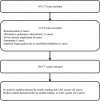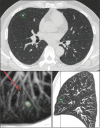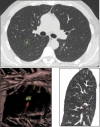Evaluating the performance of a deep learning-based computer-aided diagnosis (DL-CAD) system for detecting and characterizing lung nodules: Comparison with the performance of double reading by radiologists
- PMID: 30536611
- PMCID: PMC6360226
- DOI: 10.1111/1759-7714.12931
Evaluating the performance of a deep learning-based computer-aided diagnosis (DL-CAD) system for detecting and characterizing lung nodules: Comparison with the performance of double reading by radiologists
Abstract
Background: The study was conducted to evaluate the performance of a state-of-the-art commercial deep learning-based computer-aided diagnosis (DL-CAD) system for detecting and characterizing pulmonary nodules.
Methods: Pulmonary nodules in 346 healthy subjects (male: female = 221:125, mean age 51 years) from a lung cancer screening program conducted from March to November 2017 were screened using a DL-CAD system and double reading independently, and their performance in nodule detection and characterization were evaluated. An expert panel combined the results of the DL-CAD system and double reading as the reference standard.
Results: The DL-CAD system showed a higher detection rate than double reading, regardless of nodule size (86.2% vs. 79.2%; P < 0.001): nodules ≥ 5 mm (96.5% vs. 88.0%; P = 0.008); nodules < 5 mm (84.3% vs. 77.5%; P < 0.001). However, the false positive rate (per computed tomography scan) of the DL-CAD system (1.53, 529/346) was considerably higher than that of double reading (0.13, 44/346; P < 0.001). Regarding nodule characterization, the sensitivity and specificity of the DL-CAD system for distinguishing solid nodules > 5 mm (90.3% and 100.0%, respectively) and ground-glass nodules (100.0% and 96.1%, respectively) were close to that of double reading, but dropped to 55.5% and 93%, respectively, when discriminating part solid nodules.
Conclusion: Our DL-CAD system detected significantly more nodules than double reading. In the future, false positive findings should be further reduced and characterization accuracy improved.
Keywords: Computer-aided diagnosis (CAD); deep learning based computer-aided diagnosis (DL-CAD); double reading; lung nodule screening; nodule characterization.
© 2018 The Authors. Thoracic Cancer published by China Lung Oncology Group and John Wiley & Sons Australia, Ltd.
Figures


 ) CAD and (
) CAD and ( ) manually.
) manually.



Similar articles
-
Performance of a deep learning-based lung nodule detection system as an alternative reader in a Chinese lung cancer screening program.Eur J Radiol. 2022 Jan;146:110068. doi: 10.1016/j.ejrad.2021.110068. Epub 2021 Nov 24. Eur J Radiol. 2022. PMID: 34871936
-
Efficiency of a computer-aided diagnosis (CAD) system with deep learning in detection of pulmonary nodules on 1-mm-thick images of computed tomography.Jpn J Radiol. 2020 Nov;38(11):1052-1061. doi: 10.1007/s11604-020-01009-0. Epub 2020 Jun 26. Jpn J Radiol. 2020. PMID: 32592003
-
Computer-aided detection of pulmonary nodules: a comparative study using the public LIDC/IDRI database.Eur Radiol. 2016 Jul;26(7):2139-47. doi: 10.1007/s00330-015-4030-7. Epub 2015 Oct 6. Eur Radiol. 2016. PMID: 26443601 Free PMC article.
-
A review of lung cancer screening and the role of computer-aided detection.Clin Radiol. 2017 Jun;72(6):433-442. doi: 10.1016/j.crad.2017.01.002. Epub 2017 Feb 6. Clin Radiol. 2017. PMID: 28185635 Review.
-
A survey of computer-aided diagnosis of lung nodules from CT scans using deep learning.Comput Biol Med. 2021 Oct;137:104806. doi: 10.1016/j.compbiomed.2021.104806. Epub 2021 Aug 25. Comput Biol Med. 2021. PMID: 34461501 Review.
Cited by
-
A Synthesizing Semantic Characteristics Lung Nodules Classification Method Based on 3D Convolutional Neural Network.Bioengineering (Basel). 2023 Oct 25;10(11):1245. doi: 10.3390/bioengineering10111245. Bioengineering (Basel). 2023. PMID: 38002369 Free PMC article.
-
The Performance of Deep Learning Algorithms on Automatic Pulmonary Nodule Detection and Classification Tested on Different Datasets That Are Not Derived from LIDC-IDRI: A Systematic Review.Diagnostics (Basel). 2019 Nov 29;9(4):207. doi: 10.3390/diagnostics9040207. Diagnostics (Basel). 2019. PMID: 31795409 Free PMC article. Review.
-
Influence of CT dose reduction on AI-driven malignancy estimation of incidental pulmonary nodules.Eur Radiol. 2024 May;34(5):3444-3452. doi: 10.1007/s00330-023-10348-1. Epub 2023 Oct 23. Eur Radiol. 2024. PMID: 37870625 Free PMC article.
-
Artificial intelligence in lung cancer: current applications and perspectives.Jpn J Radiol. 2023 Mar;41(3):235-244. doi: 10.1007/s11604-022-01359-x. Epub 2022 Nov 9. Jpn J Radiol. 2023. PMID: 36350524 Free PMC article. Review.
-
Impact of artificial intelligence assistance on pulmonary nodule detection and localization in chest CT: a comparative study among radiologists of varying experience levels.Sci Rep. 2024 Sep 28;14(1):22447. doi: 10.1038/s41598-024-73435-3. Sci Rep. 2024. PMID: 39341945 Free PMC article.
References
-
- World Health Organization . Cancer Fact sheet No 297 2013. [Cited 23 Nov 2018.] Available from URL: http://www.who.int/news-room/fact-sheets/detail/cancer
-
- Stewart B, Wild C. World Cancer Report 2014. 2015. International Agency for Research on Cancer, Lyon.
-
- International Early Lung Cancer Action Program Investigators , Henschke CI, Yankelevitz DF et al Survival of patients with stage I lung cancer detected on CT screening. N Engl J Med 2006; 355: 1763–71. - PubMed
-
- Li F, Sone S, Abe H, MacMahon H, Armato SG III, Doi K. Lung cancers missed at low‐dose helical CT screening in a general population: Comparison of clinical, histopathologic, and imaging findings. Radiology 2002; 225: 673–83. - PubMed
Publication types
MeSH terms
LinkOut - more resources
Full Text Sources
Miscellaneous

